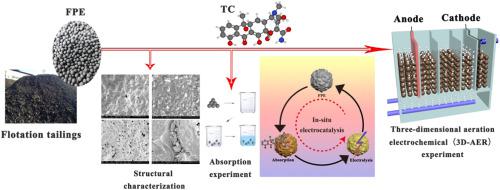Journal of Hazardous Materials ( IF 12.2 ) Pub Date : 2020-11-19 , DOI: 10.1016/j.jhazmat.2020.124361 Shumin Yang , Yan Feng , Dong Gao , Xinwei Wang , Ning Suo , Yanzhen Yu , Shoubin Zhang

|
Novel particle electrodes, i.e. flotation tailings particle electrode (FPE), were prepared using flotation tailings, garden soil, and soluble starch with a mass ratio of 16:3:1, and then used in tetracycline wastewater treatment. The physicochemical properties of FPE were systematically characterized using SEM, XRD, FT-IR and XRF. Tetracycline adsorption and its adsorption mechanism onto FPE was explored for the first time. Parameters affecting FPE’s degradation efficiency and energy consumption such as current density, electrolysis time, initial concentration, initial pH and aeration rate were examined. The electrocatalytic degradation of tetracycline shows that the degradation of tetracycline meets the pseudo-first-order kinetics. Moreover, the numbers of •OH produced on the surfaces of the cathode, anode and particle electrode were compared. Results showed that the adsorption-saturated FPE can be regenerated by electrochemical action to induce further absorption and form in-situ electrocatalysis. In order to find out the transformation products in water and degradation pathways of Tetracycline, UHPLC method was used to obtain the degradation pathways for Tetracycline. So, this work could provide a fabrication of high-efficiency and low-cost electrocatalytic for removal of pharmaceuticals pollutants from waste water as well as deeper insight into electrocatalytic mechanism, transformation products, and degradation pathways of Tetracycline in water.
中文翻译:

浮尾粒子电极(FPE)在三维曝气电催化反应器(3D-AER)中对四环素的电催化降解:理化性质,影响因素及降解机理
利用浮选尾矿,菜园土壤和质量比为16:3:1的可溶性淀粉制备了新型的浮选尾矿颗粒电极(FPE),然后用于四环素废水处理。利用SEM,XRD,FT-IR和XRF对FPE的理化性质进行了系统表征。首次探讨了四环素在FPE上的吸附及其吸附机理。检查了影响FPE降解效率和能耗的参数,例如电流密度,电解时间,初始浓度,初始pH和曝气速率。四环素的电催化降解表明四环素的降解符合拟一级动力学。而且,比较了在阴极,阳极和颗粒电极的表面上产生的•OH的数目。结果表明,吸附饱和的FPE可以通过电化学作用再生,以引起进一步的吸收并形成原位电催化。为了找出四环素在水中的转化产物和降解途径,采用UHPLC法获得了四环素的降解途径。因此,这项工作可以提供一种高效,低成本的电催化方法,用于去除废水中的药物污染物,以及更深入地了解四环素在水中的电催化机理,转化产物和降解途径。为了找出四环素在水中的转化产物和降解途径,采用UHPLC法获得了四环素的降解途径。因此,这项工作可以提供一种高效,低成本的电催化方法,用于去除废水中的药物污染物,以及更深入地了解四环素在水中的电催化机理,转化产物和降解途径。为了找出四环素在水中的转化产物和降解途径,采用UHPLC法获得了四环素的降解途径。因此,这项工作可以提供一种高效,低成本的电催化方法,用于去除废水中的药物污染物,以及更深入地了解四环素在水中的电催化机理,转化产物和降解途径。











































 京公网安备 11010802027423号
京公网安备 11010802027423号